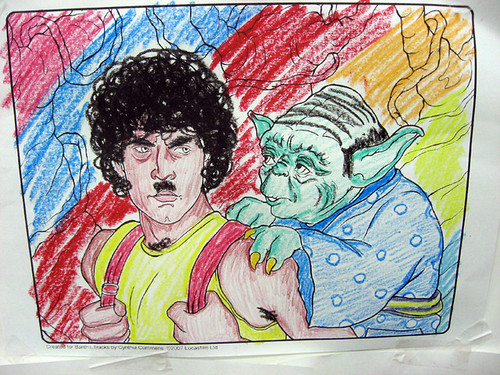## THX1138 DeHalo_alpha demonstrator
##=================
## Video path & name
clip = "THX1138 US WS 1991 LD.png"
## Get video / picture
#v1 = DirectShowSource( clip ) # for video
v1 = ImageReader( clip ) # for picture
# video / picture size
x_size = 640
y_size = 286
# original & fixed streams for processing
v1_fix = v1
##----------
## DeHalo_alpha()
## clip clp, float "rx", float "ry", float "darkstr", float "brightstr",
## float "lowsens", float "highsens", float "ss"
#
### rx, ry [float, 1.0 ... 2.0 ... ~3.0] Default 2.0
# As usual, the radii for halo removal.
# this function is rather sensitive to the radius settings. Set it as low
# as possible! If radius is set too high, it will start missing small spots.
### darkstr, brightstr [float, 0.0 ... 1.0] Default 1.0, 1.0 allowed
# The strength factors for processing dark and bright halos. Default 1.0 both
# for symmetrical processing. On Comic/Anime, darkstr=0.4~0.8 sometimes might
# be better ... sometimes. In General, the function seems to preserve dark
# lines rather good.
### lowsens, highsens [int, 0 ... 50 ... 100] Default 50
# Sensitivity settings, not that easy to describe them exactly ... in a sense,
# they define a window between how weak an achieved effect has to be to get
# fully accepted, and how strong an achieved effect has to be to get fully
# discarded.
### ss [float, 1.0 ... 1.5 ...] Default 1.5
# Supersampling factor, to avoid creation of aliasing.
##----------
# DeHalo (calls the function script at bottom)
v1_fix = v1_fix.ConvertToYV12() # DeHalo uses this format
#v1_fix = v1_fix.DeHalo_alpha( rx=2.0, ry=2.0, darkstr=1.0, brightstr=1.0 ) # defaults
v1_fix = v1_fix.DeHalo_alpha( ry=1.0, darkstr=1.5, brightstr=1.5 ) # tweaks
v1_fix = v1_fix.ConvertToRGB24() # return to default format
v1_fix = v1_fix.Levels( 24, 1.1, 248, 0, 255, coring=false ) # fix lost contrast
## display results
# add 4x magnify panel to original
v1_mag = v1
\.PointResize( x_size*4, y_size*4 )
\.Crop( x_size*10/5, y_size*10/6, x_size, y_size )
\.Crop( x_size/3, 0, x_size/2, y_size )
v1 = StackHorizontal( v1, v1_mag )
# add 4x magnify panel to fix
v1_fix_mag = v1_fix
\.PointResize( x_size*4, y_size*4 )
\.Crop( x_size*10/5, y_size*10/6, x_size, y_size )
\.Crop( x_size/3, 0, x_size/2, y_size )
v1_fix = StackHorizontal( v1_fix, v1_fix_mag )
# display before & after split screen
StackVertical( v1, v1_fix )
##==========
## Functions
##----------
##==========
## De-halo
# Here are the parameters:
# - rx, ry [float, 1.0 ... 2.0 ... ~3.0] Default 2.0
# As usual, the radii for halo removal.
# Note: this function is rather sensitive to the radius settings. Set it as low
# as possible! If radius is set too high, it will start missing small spots.
# - darkkstr, brightstr [float, 0.0 ... 1.0] Default 1.0, 1.0 allowed
# The strength factors for processing dark and bright halos. Default 1.0 both
# for symmetrical processing. On Comic/Anime, darkstr=0.4~0.8 sometimes might
# be better ... sometimes. In General, the function seems to preserve dark
# lines rather good.
# - lowsens, highsens [int, 0 ... 50 ... 100] Default 50
# Sensitivity settings, not that easy to describe them exactly ... in a sense,
# they define a window between how weak an achieved effect has to be to get
# fully accepted, and how strong an achieved effect has to be to get fully
# discarded.
# - ss [float, 1.0 ... 1.5 ...] Default 1.5
# Supersampling factor, to avoid creation of aliasing.
function DeHalo_alpha(clip clp, float "rx", float "ry", float "darkstr", float "brightstr", float "lowsens", float "highsens", float "ss")
{
rx = default( rx, 2.0 )
ry = default( ry, 2.0 )
darkstr = default( darkstr, 1.0 )
brightstr = default( brightstr, 1.0 )
lowsens = default( lowsens, 50 )
highsens = default( highsens, 50 )
ss = default( ss, 1.5 )
LOS = string(lowsens)
HIS = string(highsens/100.0)
DRK = string(darkstr)
BRT = string(brightstr)
ox = clp.width()
oy = clp.height()
uv = 1
uv2 = (uv==3) ? 3 : 2
halos = clp.bicubicresize(m4(ox/rx),m4(oy/ry)).bicubicresize(ox,oy,1,0)
are = yv12lutxy(clp.expand(U=uv,V=uv),clp.inpand(U=uv,V=uv),"x y -","x y -","x y -",U=uv,V=uv)
ugly = yv12lutxy(halos.expand(U=uv,V=uv),halos.inpand(U=uv,V=uv),"x y -","x y -","x y -",U=uv,V=uv)
so = yv12lutxy( ugly, are, "y x - y 0.001 + / 255 * "+LOS+" - y 256 + 512 / "+HIS+" + *" )
lets = maskedmerge(halos,clp,so,U=uv,V=uv)
remove = (ss==1.0) ? clp.repair(lets,1,0)
\ : clp.lanczosresize(m4(ox*ss),m4(oy*ss))
\ .logic(lets.expand(U=uv,V=uv).bicubicresize(m4(ox*ss),m4(oy*ss)),"min",U=uv2,V=uv2)
\ .logic(lets.inpand(U=uv,V=uv).bicubicresize(m4(ox*ss),m4(oy*ss)),"max",U=uv2,V=uv2)
\ .lanczosresize(ox,oy)
them = yv12lutxy(clp,remove,"x y < x x y - "+DRK+" * - x x y - "+BRT+" * - ?",U=2,V=2)
return( them )
}
function m4(float x) {return(x<16?16:int(round(x/4.0)*4))}
##==========

![]()
 Notice that the Hues are essentially flat, and uniformly cover wide areas. (Just think rooms full of women workers knife-cutting celluloid sheets of different colors for specific areas of each shot. Yep, that's how it was done!) Saturation is pretty much uniform for all those Hues ... just like in those old days.
Notice that the Hues are essentially flat, and uniformly cover wide areas. (Just think rooms full of women workers knife-cutting celluloid sheets of different colors for specific areas of each shot. Yep, that's how it was done!) Saturation is pretty much uniform for all those Hues ... just like in those old days.





















